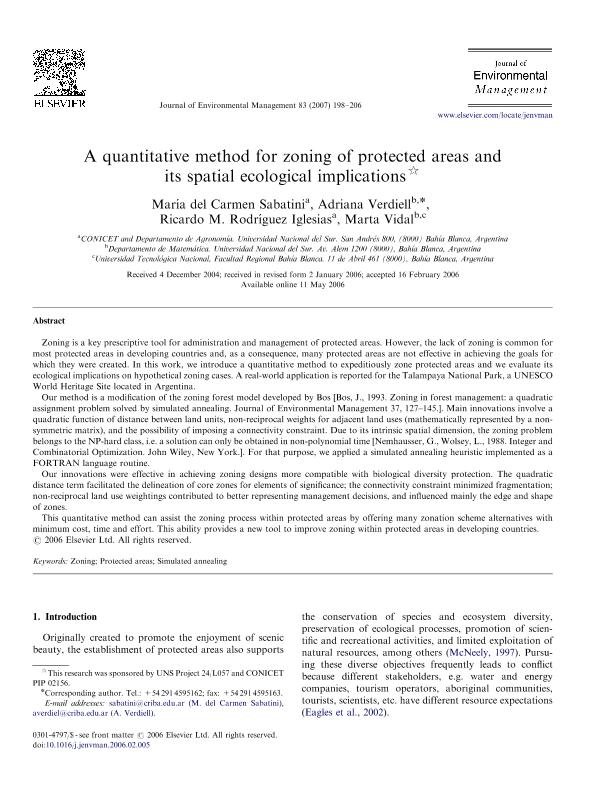Mostrar el registro sencillo del ítem
dc.contributor.author
Sabatini, Maria del Carmen
dc.contributor.author
Verdiell, Adriana Beatriz

dc.contributor.author
Rodríguez Iglesias, Ricardo Manuel

dc.contributor.author
Vidal, Marta Cecilia

dc.date.available
2019-05-09T21:47:27Z
dc.date.issued
2007-04-11
dc.identifier.citation
Sabatini, Maria del Carmen; Verdiell, Adriana Beatriz; Rodríguez Iglesias, Ricardo Manuel; Vidal, Marta Cecilia; A quantitative method for zoning of protected areas and its spatial ecological implications; Academic Press Ltd - Elsevier Science Ltd; Journal of Environmental Management; 83; 2; 11-4-2007; 198-206
dc.identifier.issn
0301-4797
dc.identifier.uri
http://hdl.handle.net/11336/76015
dc.description.abstract
Zoning is a key prescriptive tool for administration and management of protected areas. However, the lack of zoning is common for most protected areas in developing countries and, as a consequence, many protected areas are not effective in achieving the goals for which they were created. In this work, we introduce a quantitative method to expeditiously zone protected areas and we evaluate its ecological implications on hypothetical zoning cases. A real-world application is reported for the Talampaya National Park, a UNESCO World Heritage Site located in Argentina. Our method is a modification of the zoning forest model developed by Bos [Bos, J., 1993. Zoning in forest management: a quadratic assignment problem solved by simulated annealing. Journal of Environmental Management 37, 127-145.]. Main innovations involve a quadratic function of distance between land units, non-reciprocal weights for adjacent land uses (mathematically represented by a non-symmetric matrix), and the possibility of imposing a connectivity constraint. Due to its intrinsic spatial dimension, the zoning problem belongs to the NP-hard class, i.e. a solution can only be obtained in non-polynomial time [Nemhausser, G., Wolsey, L., 1988. Integer and Combinatorial Optimization. John Wiley, New York.]. For that purpose, we applied a simulated annealing heuristic implemented as a FORTRAN language routine. Our innovations were effective in achieving zoning designs more compatible with biological diversity protection. The quadratic distance term facilitated the delineation of core zones for elements of significance; the connectivity constraint minimized fragmentation; non-reciprocal land use weightings contributed to better representing management decisions, and influenced mainly the edge and shape of zones. This quantitative method can assist the zoning process within protected areas by offering many zonation scheme alternatives with minimum cost, time and effort. This ability provides a new tool to improve zoning within protected areas in developing countries.
dc.format
application/pdf
dc.language.iso
eng
dc.publisher
Academic Press Ltd - Elsevier Science Ltd

dc.rights
info:eu-repo/semantics/openAccess
dc.rights.uri
https://creativecommons.org/licenses/by-nc-sa/2.5/ar/
dc.subject
Protected Areas
dc.subject
Simulated Annealing
dc.subject
Zoning
dc.subject.classification
Ecología

dc.subject.classification
Ciencias Biológicas

dc.subject.classification
CIENCIAS NATURALES Y EXACTAS

dc.subject.classification
Matemática Pura

dc.subject.classification
Matemáticas

dc.subject.classification
CIENCIAS NATURALES Y EXACTAS

dc.subject.classification
Ciencias de la Computación

dc.subject.classification
Ciencias de la Computación e Información

dc.subject.classification
CIENCIAS NATURALES Y EXACTAS

dc.title
A quantitative method for zoning of protected areas and its spatial ecological implications
dc.type
info:eu-repo/semantics/article
dc.type
info:ar-repo/semantics/artículo
dc.type
info:eu-repo/semantics/publishedVersion
dc.date.updated
2019-05-06T16:14:11Z
dc.journal.volume
83
dc.journal.number
2
dc.journal.pagination
198-206
dc.journal.pais
Estados Unidos

dc.description.fil
Fil: Sabatini, Maria del Carmen. Consejo Nacional de Investigaciones Científicas y Técnicas. Centro Científico Tecnológico Conicet - Bahía Blanca; Argentina. Universidad Nacional del Sur. Departamento de Agronomía; Argentina
dc.description.fil
Fil: Verdiell, Adriana Beatriz. Universidad Nacional del Sur. Departamento de Matemática; Argentina
dc.description.fil
Fil: Rodríguez Iglesias, Ricardo Manuel. Consejo Nacional de Investigaciones Científicas y Técnicas. Centro Científico Tecnológico Conicet - Bahía Blanca; Argentina. Universidad Nacional del Sur. Departamento de Agronomía; Argentina
dc.description.fil
Fil: Vidal, Marta Cecilia. Universidad Tecnológica Nacional. Facultad Regional Bahía Blanca; Argentina. Universidad Nacional del Sur. Departamento de Matemática; Argentina
dc.journal.title
Journal of Environmental Management

dc.relation.alternativeid
info:eu-repo/semantics/altIdentifier/url/https://www.sciencedirect.com/science/article/pii/S030147970600082X
dc.relation.alternativeid
info:eu-repo/semantics/altIdentifier/doi/http://dx.doi.org/10.1016/j.jenvman.2006.02.005
Archivos asociados
